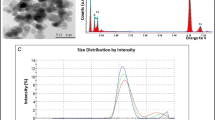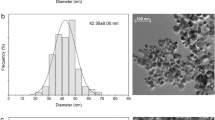Abstract
Olfactory tract has been demonstrated to be an important portal for inhaled solid nanoparticle transportation into the central nervous system (CNS). We have previously demonstrated that intranasally instilled Fe2O3 nanoparticles could transport into the CNS via olfactory pathway. In this study, we investigated the neurotoxicity and size effect of repeatedly low-dose (130 μg) intranasal exposure of nano- and submicron-sized Fe2O3 particles (21 nm and 280 nm) to mice. The biomarkers of oxidative stress, activity of nitric oxide synthases and release of monoamine neurotransmitter in the brain were studied. Our results showed that significant oxidative stress was induced by the two sizes of Fe2O3 particles. The activities of GSH-Px, Cu,Zn-SOD, and cNOS significantly elevated and the total GSH and GSH/GSSG ratio significantly decreased in the olfactory bulb and hippocampus after the nano- and submicron-sized Fe2O3 particle treatment (p < 0.05). The nano-sized Fe2O3 generally induced greater alteration and more significant dose–effect response than the submicron-sized particle did. Some slight perturbation of monoamine neurotransmitters were found in the hippocampus after exposure to the two sizes of Fe2O3 particle. The TEM image showed that some ultrastructural alterations in nerve cells, including neurodendron degeneration, membranous structure disruption and lysosome increase in the olfactory bulb, slight dilation in the rough endoplasmic reticulum and lysosome increase in the hippocampus were induced by the nano-sized Fe2O3 treatment. In contrast, in the submicron-sized Fe2O3 treated mice, slightly swollen mitochondria and some vacuoles were observed in the olfactory bulb and hippocampus, respectively. These results indicate that intranasal exposure of Fe2O3 nanoparticles could induce more severe oxidative stress and nerve cell damage in the brain than the larger particle did. This is the first study to compare the neurotoxicity of nano- and submicron-sized Fe2O3 particles in the central nervous system after long-term and low-dose intranasal exposure.












Similar content being viewed by others
References
Aisen P, Wessling-Resnick M, Leibold EA (1999) Iron metabolism. Curr Opin Chem Biol 3:200–206. doi:10.1016/S1367-5931(99)80033-7
Au WW, Treloar HB, Greer CA (2002) Sublaminar organization of the mouse olfactory bulb nerve layer. J Comp Neurol 446:68–80. doi:10.1002/cne.10182
Baker MA, Cerniglia GJ, Zaman A (1990) Microtiter plate assay for the measurement of glutathione and glutathione disulfide in large numbers of biological samples. Anal Biochem 190:360–365. doi:10.1016/0003-2697(90)90208-Q
Bradford MM (1976) A rapid and sensitive method for the quantitation of microgram quantities of protein utilizing the principle of protein-dye binding. Anal Biochem 72:248–254. doi:10.1016/0003-2697(76)90527-3
Bush AI (2003) The metallobiology of Alzheimer’s disease. Trends Neurosci 26:207–214. doi:10.1016/S0166-2236(03)00067-5
Deibel MA, Ehmann WD, Markesbery WR (1996) Copper, iron and zinc imbalances in severely degenerated brain regions in Alzheimer’s disease: possible relation to oxidative stress. J Neurol Sci 143:137–142. doi:10.1016/S0022-510X(96)00203-1
DeLorenzo A (1970) The olfactory neuron and the blood-brain barrier. In: Wolstenholme G, Knight J (eds) Taste and smell in vertebrates CIBA foundation symposium series. J&A Churchill, London, pp 151–176
Donaldson K, Stone V (2003) Current hypotheses on the mechanisms of toxicity of ultrafine particles. Ann Ist Super Sanita 39(3):405–410
Donaldson K, Stone V, Clouter A, Renwick L, MacNee W (2001) Ultrafine particles. Occup Environ Med 58:211–216. doi:10.1136/oem.58.3.211
Elder A, Gelein R, Silva V, Feikert T, Opanashuk L, Carter J et al (2006) Translocation of inhaled ultrafine manganese oxide particles to the central nervous system. Environ Health Perspect 114(8):1172–1178
Flohe L, Gunzler WA (1984) Glutathione peroxidase. Methods Enzymol 105:115–121
Foley S, Crowley C, Smaihi M, Bonfils C, Erlanger BF, Seta P et al (2002) Cellular localization of a water-soluble fullerene derivative. Biochem Biophys Res Commun 294:116–119. doi:10.1016/S0006-291X(02)00445-X
Hautot D, Pankhurst QA, Morris CM, Curtis A, Burn J, Dobson J (1772/2007) Preliminary observation of elevated levels of nanocrystalline iron oxide in the basal ganglia of neuroferritinopathy patients. Biochim Biophys Acta (1):21–25
Heales SJR, Bolafios JP, Clark JB (1996) Glutathione depletion is accompanied by increased neuronal nitric oxide synthase activity. Neurochem Res 21(1):35–39. doi:10.1007/BF02527669
Hoet PHM, Brüske-Hohlfeld I, Salata OV (2004) Nanoparticles—known and unknown health risks. J Nanobiotechnol 2:12–27. doi:10.1186/1477-3155-2-12
Hölscher C (1997) Nitric oxide, the enigmatic neuronal messenger: its role in synaptic plasticity. Trends Neurosci 20:298–303. doi:10.1016/S0166-2236(97)01065-5
Horányi G, Kálmán E (2004) Anion specific adsorption on Fe2O3 and AlOOH nanoparticles in aqueous solutions: comparison with hematite and γ-Al2O3. J Colloid Interface Sci 269:315–319. doi:10.1016/S0021-9797(03)00750-1
Hussain SM, Javorina AK, Schrand AM, Duhart HM, Ali SF, Schlager JJ (2006) The interaction of manganese nanoparticles with PC-12 cells induces dopamine depletion. Toxicol Sci 92(2):456–463. doi:10.1093/toxsci/kfl020
Li N, Sioutas C, Cho A, Schmitz D, Misra C, Sempf J et al (2003) Ultrafine particulate pollutants induce oxidative stress and mitochondrial damage. Environ Health Perspect 111:455–460
Lin AMY (1999) Recovery by NO of the iron-attenuated dopamine dynamics in nigrostriatal system of rat brain. Neurosci Res 34:133–139. doi:10.1016/S0168-0102(99)00054-1
Lipton SA, Choy YB, Pan ZH, Lei SZ, Chen HS, Sucher NJ et al (1993) A redox-based mechanism for the neuroprotective effects of nitric oxide and related nitroso-compounds. Nature 364:626–632. doi:10.1038/364626a0
Long TC, Saleh N, Tilton RD, Lowry GV, Veronesi B (2006) Titanium dioxide (P25) produces reactive oxygen species in immortalized brain microglia (BV2): implications for nanoparticle neurotoxicity. Environ Sci Technol 40(14):4346–4352. doi:10.1021/es060589n
MacNee W, Donaldson K (2003) Mechanism of lung injury caused by PM10 and ultrafine particles with special reference to COPD. Eur Respir J Suppl 40:47s–51s. doi:10.1183/09031936.03.00403203
Maynard AD, Kuempel ED (2005) Airborne nanostructured particles and occupational health. J Nanopart Res 7:587–614. doi:10.1007/s11051-005-6770-9
Misra HP, Fridovich I (1972) The role of superoxide anion in the autooxidation of the epinephrine and a sample assay for superoxide dismutase. J Biol Chem 247:3170–3175
Nel A, Xia T, Mädler L, Li N (2006) Toxic potential of materials at the nanolevel. Science 311:622–627
Nemmar A, Vanbilloen H, Hoylaerts MF, Hoet PHM, Verbruggen A, Nemery B (2001) Passage of intratracheally instilled ultrafine particles from the lung into the systemic circulation in hamster. Am J Respir Crit Care Med 164:1665–1668
Oberdörster E (2004) Manufactured nanomaterials (Fullerenes, C60) induce oxidative stress in the brain of juvenile largemouth bass. Environ Health Perspect 112(10):1058–1062
Oberdörster G, Sharp Z, Atudorei V, Elder A, Gelein R, Kreyling W (2004) Translocation of inhaled ultrafine particles to the brain. Inhal Toxicol 16(6–7):437–445. doi:10.1080/08958370490439597
Ohkawa H, Ohishi N, Yagi K (1979) Assay for lipid peroxides in animal tissues by thiobarbituric acid reaction. Anal Biochem 95:351–358. doi:10.1016/0003-2697(79)90738-3
Papaioannou A, Dafni U, Alikaridis F, Bolaris S, Stylianopoulou F (2002) Effects of neonatal handling on basal and stress-induced monoamine levels in the male and female rat brain. Neuroscience 114(1):195–206. doi:10.1016/S0306-4522(02)00129-X
Penpolcharoen M, Amal R, Brungs M (2001) Degradation of sucrose and nitrate over titania coated nano-hematite photocatalysts. J Nanopart Res 3:289–302. doi:10.1023/A:1017929204380
Peters A, Wichmann HE, Tuch T, Heinrich J, Heyder J (1997) Respiratory effects are associated with the number of ultrafine particles. Am J Respir Crit Care Med 155:1376–1383
Pisanic TRII, Blackwell JD, Shubayev VI, Fiñones RR, Jin S (2007) Nanotoxicity of iron oxide nanoparticle internalization in growing neurons. Biomaterials 28:2572–2581. doi:10.1016/j.biomaterials.2007.01.043
Prast H, Philippu A (2001) Nitric oxide as modulator of neuronal function. Prog Neurobiol 64:51–68. doi:10.1016/S0301-0082(00)00044-7
Qian ZM, Shen X (2001) Brain iron transport and neurodegeneration. Trends Mol Med 7:103–108. doi:10.1016/S1471-4914(00)01910-9
Rodoslav S, Laibin L, Eisenberg A, Dusica M (2003) Micellar nanocontainers distribute to defined cytoplasmic organelles. Science 300:615–618. doi:10.1126/science.1078192
Salter M, Knowles RG, Moncada S (1991) Widespread tissue distribution, species distribution and changes in activity of Ca2+-dependent and Ca2+-independent nitric oxide synthases. FEBS Lett 291:145–149. doi:10.1016/0014-5793(91)81123-P
Samudralwer DL, Diprete CC, Ni BF, Ehmann WD, Markesbery WR (1995) Elemental imbalances in the olfactory pathway in Alzheimer’s disease. J Neurol Sci 130:139–145. doi:10.1016/0022-510X(95)00018-W
Sayre LM, Perry G, Smith MA (1999) Redox metals and neurodegenerative disease. Curr Opin Chem Biol 3:220–225. doi:10.1016/S1367-5931(99)80035-0
Schulz JB, Matthews RT, Jenkins BG, Ferrante RJ, Siwek D, Henshaw DR et al (1995) Blockade of neuronal nitric oxide synthase protects against excitotoxicity in vivo. J Neurosci 15:8419–8429
Shvedova AA, Kisin ER, Mercer R, Murray AR, Johnson VJ, Potapovich AI et al (2005) Unusual inflammatory and fibrogenic pulmonary responses to single walled carbon nanotubes in mice. Am J Physiol Lung Cell Mol Physiol 289:L698–L708. doi:10.1152/ajplung.00084.2005
Siegel GJ, Agranoff BW, Albers RW, Fischer SK, Uhler MD (eds) (1985) Basic neurochemistry: molecular, cellular and medical aspects, 6th edn. Lippincott Raven, Philadelphia
Sun Y, Oberley LW, Li Y (1988) A simple method for clinical assay of superoxide dismutase. Clin Chem 34(3):497–500
Thompson KJ, Shoham S, Connor JR (2001) Iron and neurodegenerative disorders. Brain Res Bull 55:155–164. doi:10.1016/S0361-9230(01)00510-X
Tin-Tin-Win-Shwe, Yamamoto S, Ahmed S, Kakeyama M, Kobayashi T, Fujimaki H (2006) Brain cytokine and chemokine mRNA expression in mice induced by intranasal instillation with ultrafine carbon black. Toxicol Lett 163(2):153–160. doi:10.1016/j.toxlet.2005.10.006
Utell MJ, Frampton MW (2000) Acute health effects of ambient air pollution: the ultrafine particle hypothesis. J Aerosol Med 13:355–359
Wang B, Feng WY, Wang M, Shi JW, Zhang F, Ouyang H et al (2007) Transport of intranasally instilled fine Fe2O3 particles into the brain: micro-distribution, chemical states, and histopathological observation. Biol Trace Elem Res 118:233–243. doi:10.1007/s12011-007-0028-6
Wörle-Knirsch JM, Kern K, Schleh C, Adelhelm C, Feldmann C, Krug HF (2007) Nanoparticulate vanadium oxide potentiated vanadium toxicity in human lung cells. Environ Sci Technol 41(1):331–336. doi:10.1021/es061140x
Xia T, Kovochich M, Brant J, Hotze M, Sempf J, Oberley T et al (2006) Comparison of the abilities of ambient and manufactured nanoparticles to induce cellular toxicity according to an oxidative stress paradigm. Nano Lett 6(8):1794–1807. doi:10.1021/nl061025k
Zhou YM, Zhong CY, Kennedy IM, Pinkerton KE (2003) Pulmonary responses of acute exposure to ultrafine iron particles in healthy adult rats. Environ Toxicol 18:227–235. doi:10.1002/tox.10119
Acknowledgments
The authors are grateful to the foundations of MOST 973 program (2006CB705605, 2007CB935604, and 2006CB932505), the Chinese Academy of Sciences (KJCX3.SYW.N3) and the National Natural Science Foundation of China (10490181, 10675139, and 10525524).
Author information
Authors and Affiliations
Corresponding authors
Rights and permissions
About this article
Cite this article
Wang, B., Feng, W., Zhu, M. et al. Neurotoxicity of low-dose repeatedly intranasal instillation of nano- and submicron-sized ferric oxide particles in mice. J Nanopart Res 11, 41–53 (2009). https://doi.org/10.1007/s11051-008-9452-6
Received:
Accepted:
Published:
Issue Date:
DOI: https://doi.org/10.1007/s11051-008-9452-6




